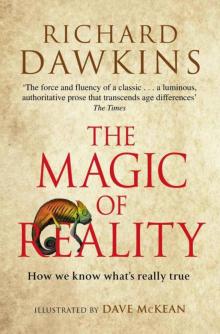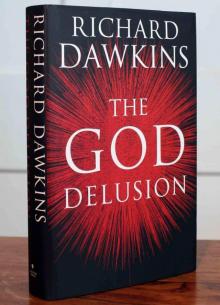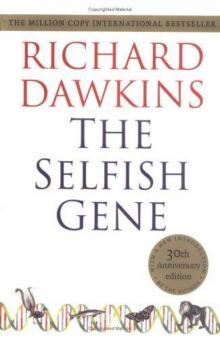- Home
- Richard Dawkins
Outgrowing God Page 5
Outgrowing God Read online
Page 5
The stories of Adam and Eve, and of Noah and his Ark, are not history, and no educated theologian thinks they are. Like countless such stories from all over the world, they are ‘myths’. There’s nothing wrong with myths. Some are beautiful and most are interesting, but they aren’t history. Unfortunately, many uneducated people, especially in America and the Islamic world, think they are. All peoples have myths. The two I’ve just been talking about are Jewish myths, which have become extremely well known throughout the world simply because they happened to be gathered into the sacred canons of Judaism, Christianity and Islam.
It’s seldom clear how an ancient myth got started. Perhaps there was an original story about something that did actually happen, say a daring deed by some local hero like Achilles or Robin Hood. Maybe an imaginative storyteller entertained people round the camp fire with a yarn – which might have been either a garbled version of something that once happened, or a piece of fiction made up just for fun, perhaps like the tale of Sinbad the Sailor. Such a storyteller might make use of characters from earlier myths that would have been already well known to his audience: figures like Hercules, Achilles, Apollo, Theseus. Or, coming up to our own time, like Brer Rabbit or Superman or Spider-Man. What’s more, the storyteller might not have thought of his stories as pure fiction for entertainment. He might have intended them as moral tales. Like Jesus’s parable of the Good Samaritan. Or like Aesop’s Fables.
Myths often have a dreamlike quality, and sometimes the original inventor of the story may have been recounting a dream. Throughout history, lots of people have believed their dreams were filled with meaning. Dreams have been thought to foretell the future. Australian aborigines trace their mythology from a mysterious dawn age in the ancestral past, which they call the Dreamtime.
However a story starts, whether in truth or fiction, parable or dream, the Chinese Whispers effect will see to it that it changes as it’s repeated and re-repeated down the generations. Noble deeds become exaggerated, eventually often to superhuman levels. Sometimes the names get altered, as when the Utnapishtim character in the Sumerian legend became the Noah character in the Hebrew retelling. All kinds of details change. Successive storytellers ‘improve’ the story, changing details to make it funnier. Or to make it fit with their previous beliefs or wishful thinking. Or simply to make events in the story more typical of an already well-loved character. So, by the time the story is finally written down, little of the original survives. It’s become a myth.
The development of a myth can be very rapid, as we know from those fascinating cases that have started in our own time so that we’ve actually been able to watch their birth and development. There are many myths about Elvis Presley being seen alive, which might make you think twice about the similar stories of Jesus’s resurrection.
My favourite example of a modern myth is the ‘cargo cults’ of New Guinea and various Melanesian islands in the Pacific. During the Second World War, many islands were occupied by Japanese, American, British or Australian troops. These military outposts were richly supplied with goods – food, fridges, radios, telephones, cars and so on. Something similar had been going on since the nineteenth century, with supplies brought in for colonial administrators, missionaries and so on. But the scale of the wartime deliveries especially dazzled the islanders. No foreigner was ever seen growing crops, or making cars or fridges, or doing almost anything useful. And yet those wonderful things kept arriving, dropping out of the sky. Literally out of the sky during the war, because they came in big cargo planes. It seemed obvious to the islanders that all that lovely cargo must come from the gods, or from the ancestors (who were worshipped as gods). And since the invaders never did any useful work to get stuff, the things they did do must be religious ceremonies. They must be designed to please the cargo gods and persuade them to rain yet more cargo down from heaven. So the islanders tried to imitate these ceremonies, thinking this would please the cargo gods.
How did they do that? Well, it was clear that the airport must be some kind of sacred, holy place, because that’s where the cargo planes homed in. So the islanders decided to make their own ‘airport’ in a forest clearing, complete with dummy control tower, dummy radio masts and dummy planes on the dummy runway. After the war, when the military outposts had departed and the cargo stopped arriving from the sky, the islanders hoped for a ‘second coming’. They redoubled their efforts to please the cargo gods and bring back the lost but remembered age of glorious plenty.
Cargo cults sprang up dozens of times independently, on lots of islands widely separated from each other. Some of them are still going strong. On the island of Tanna (Vanuatu), the related cult of ‘John Frum’ still exists. John Frum is a mythical, messiah-like figure who, the islanders believe, will one day return to take care of his people. Like Jesus. The name seems to come from an American soldier known as ‘John from America’ (in American English ‘from’ sounds like ‘frum’, rhyming with ‘come’). Another version of the cult worships ‘Tom Navy’. In each case, the name may be grafted on to a personality derived from an older tribal god – just as when ‘Utnapishtim’ became ‘Noah’.
Yet another cult, also on Tanna, worships Prince Philip as a god. Not exactly cargo in this case, but a tall, handsome naval officer who must have looked pretty dazzling in his white uniform, and sufficiently god-like to be cheered by crowds wherever he went. That seems to have kick-started the Chinese Whispers process. The Prince Philip myth has grown ever since 1974 when he visited the island, and some inhabitants are still, in 2018, looking forward to his Second Coming.
These modern religious cults give us a good idea of how easily myths can arise. Perhaps you’ve seen Monty Python’s film Life of Brian? The hero, Brian, is unfortunately mistaken for the Messiah. Running frantically away from the adoring crowds, he drops a gourd and also loses one of his sandals. Almost immediately there is a ‘schism’ with the worshippers splitting into two rival groups. One group follows the sacred sandal, the other group the sacred gourd. Do see the film if you get the chance – it is very funny indeed, and a perfect satire on the way religions get started.
David Attenborough, one of my favourite people (surely one of everybody’s favourite people), tells of a conversation he had on Tanna with a John Frum worshipper called Sam. He pointed out to Sam that after 19 years the second coming of John Frum had still not happened.
Sam lifted his eyes from the ground and looked at me. ‘If you can wait two thousand years for Jesus Christ to come an’ ‘e no come, then I can wait more than nineteen years for John.’
Sam had a point (although he was wrong to assume David Attenborough is a believing Christian). The early Christians believed Jesus’s Second Coming would happen during their own lifetimes, and his own words, as quoted in the gospels, suggest that Jesus – or at least, the people who wrote his teachings down – thought so too.
Mormonism is another relatively recent cult which, unlike the John Frum or cargo cults, or the ‘Elvis is Risen’ cult, has spread all over the world and become rich and powerful. The founder was a man from New York State called Joseph Smith. He claimed that in 1823 an angel called Moroni told him where to dig up some golden plates which had ancient writing on them. Smith said he did so, and translated the writing from an old Egyptian language into English. He did this with the aid of a magic stone in a magic hat. When he looked in the hat, the stone revealed to him the meaning of the words. He published his English ‘translation’ in 1830. Weirdly, the English was not the English of his own time but the English of more than two centuries earlier, the English of the King James Bible. Mark Twain joked that if you cut out every repetition of ‘It came to pass’, the Book of Mormon would shrink to a pamphlet.
Why? What did Smith think he was playing at? Did he think God spoke English? And sixteenth-century English at that? It reminds me of the story (perhaps false, but very ‘spreadable’, like the story of the helium-filled dolls) of an ex-Governor of Tex
as called Miriam A. Ferguson. Disliking the idea of Spanish being made an official language in Texas, she is alleged to have said: ‘If English was good enough for Jesus, it’s good enough for me.’
You’d think Joseph Smith’s use of archaic English would have been enough to arouse people’s suspicions that he was a fake. That plus the fact that a court had earlier found him guilty of fraud. Nevertheless, he soon attracted followers, and now he has millions. Not long after Smith was murdered in 1844, his cult grew into a major new religion, under a charismatic leader called Brigham Young. Moses-like (you see how myths borrow from earlier myths), Brigham Young led his followers on a wandering pilgrimage to find a promised land. It turned out to be the state of Utah. Today they pretty much run the state. And Mormonism has now spread around the world under the name ‘Church of Latter Day Saints’ or ‘LDS’. There’s a colossal Mormon temple in Salt Lake City and at least a hundred more great temples around America and the world. Mormonism is no longer a local cult like the John Frum cult of Vanuatu. Mormons include prosperous leaders of American industry, men in suits with university degrees, one man who almost became US President. Mormons are expected to give 10 per cent of their income to the church, which as a result has become fabulously wealthy – as you can see if you look at those amazing temples.
Yet these prosperous Mormon gentlemen believe things which are positively known, from scientific evidence, to be absurd: complete and utter made-up nonsense. For example, the Book of Mormon explains in detail that Native Americans are descended from Israelites who migrated to North America around 600 BC. As if it weren’t obvious, DNA evidence conclusively shows this to be false. Once again, you might think that would be enough to show the Mormons that Smith was a charlatan. But not a bit of it.
It gets worse. Some years after producing the Book of Mormon, Smith claimed to have translated some ancient Egyptian documents that had been bought by a collector after they were discovered near Thebes in Egypt. Smith published his ‘translation’ as the ‘Book of Abraham’ in 1842, claiming it was a description of Abraham’s life and journey to Egypt. There’s lots of detail about Abraham’s early life and about Egyptian history and astronomy, pages and pages of it. In 1880, Smith’s Book of Abraham was officially ‘canonized’ by the Mormon Church.
Experts on Egyptian hieroglyphics suspected that Smith’s ‘translation’ was a fake. In the words of a 1912 letter by a curator in the Metropolitan Museum of New York, the Book of Abraham was ‘a pure fabrication…a farrago of nonsense from beginning to end’. But it was still possible for devout Mormons to keep faith with it, for the original papyruses were supposed to have been lost when the Chicago museum that housed them caught fire in 1871. Unfortunately for Joseph Smith, not all the papyruses were destroyed. Some of them were rediscovered in 1966. By this time, scholars understood the language in which the documents were written. When they were properly translated, by both Mormon and non-Mormon scholars who actually knew the language, it turned out they were about something completely different. Nothing to do with Abraham at all. Joseph Smith’s ‘translation’ was an elaborate, and obviously deliberate, hoax.
So, we positively know that Smith’s Book of Abraham was a fake translation of manuscripts that really existed. Isn’t it rather likely that his earlier ‘translation’ of the Book of Mormon, using a magic stone in a magic hat, and working from ‘golden plates’ which mysteriously ‘disappeared’ so that nobody else could see them, was also a fake? You might think the Mormons would have got the point. But even Smith’s obviously dishonest faking of the ‘Book of Abraham’ wasn’t enough to shake the faith of believers.
I suspect that this shows the amazing power of childhood indoctrination. People who are brought up in a religion have great difficulty shaking it off. And then they pass it on to the next generation. And so on. The Church of Latter Day Saints is now one of the fastest-growing religions in the world. Think about that, and perhaps you can see how, in an earlier age when there were no newspapers, no internet, no books, nothing but word-of-mouth gossip for decades after Jesus’s death, the cult of Christ was able to take off – virgin birth, miracles, resurrection, ascension into heaven and all.
Unlike the myths of Mormon and John Frum, the Old Testament myths like the Garden of Eden were invented too long ago for us to know how they started. Every tribe has its origin myth – not surprisingly, since people are naturally curious about where they came from, where all the animals came from, how the world, the sun, the moon and the stars came into being. The story of the Garden of Eden is the origin myth of the Jews. Out of all the thousands of origin myths from around the world, it was the Jewish origin myth that happened to get into the Christian Bible – simply because of the twin historical accidents of Jesus being a Jew and the Emperor Constantine’s conversion to Christianity. Unlike the Noah story, the Adam and Eve myth might not come from a Babylonian source. Funnily enough, it has similarities with the origin myth of the Pygmies, tiny people who live in the Central African forests.
You’ll remember that, in the Jewish myth, Adam was created from ‘the dust of the ground’. God ‘breathed into his nostrils the breath of life; and man became a living soul’. Rather like a gardener, God then grew Eve as a sort of cutting, from one of Adam’s ribs. Incidentally, you’d be amazed at how many people seriously think – on the basis of this myth – that men have one rib missing!
Adam and Eve were placed in a lovely garden, the Garden of Eden. God told them they were free to eat anything they liked in the garden, with one important exception. One particular tree in the middle of the garden, the Tree of Knowledge of Good and Evil, was strictly out of bounds. They must on no account eat its fruit. That was fine for a while. But then a talking snake sidled up to Eve and persuaded her to eat the forbidden fruit of the Tree of Knowledge. She did, and she persuaded Adam to try it too. Alas! Immediately they were filled with forbidden knowledge, including the fact that they were naked. Shy of their nakedness, they made themselves aprons out of leaves. This gave the game away to God, ‘walking in the garden in the cool of the day’ (lovely phrase). He realized that they must have eaten the dreaded fruit. He was furious. Poor Adam and Eve were banished for ever from the beautiful garden. Adam and his male descendants were condemned to back-breaking labour all their lives. Eve and her female descendants were condemned to the pains of childbirth. And the snake and its descendants were condemned to slither along the ground without any legs (and presumably to losing the power of speech).
Now compare that Jewish origin myth with this one from the Pygmies. The resemblance was pointed out by a Belgian anthropologist who lived among the Pygmies of the Ituri forest, studied their language and translated various similar versions of their origin myth. Here’s one version.
One fine day in heaven, God told his chief helper to make the first man. The angel of the moon descended. He modelled the first man from earth, wrapped a skin around the earth, poured blood into the skin, and punched holes for the nostrils, eyes, ears and mouth. He made another hole in the first man’s bottom, and put all the organs in his insides. Then he breathed his own vital force into the little earthen statue. He entered into the body. It moved…It sat up…It stood up…It walked. It was Efé, the first man and father of all who came after.
God said to Efé, ‘Beget children to people my forest. I shall give them everything they need to be happy. They will never have to work. They will be lords of the earth. They will live forever. There is only one thing I forbid them. Now – listen well – give my words to your children, and tell them to transmit this commandment to every generation. The tahu tree is absolutely forbidden to man. You must never, for any reason, violate this law.’
Efé obeyed these instructions. He, and his children, never went near the tree. Many years passed. Then God called to Efé, ‘Come up to heaven. I need your help!’ So Efé went up to the sky. After he left, the ancestors lived in accordance with his laws and teachings for a long, long time. T
hen, one terrible day, a pregnant woman said to her husband, ‘Darling, I want to eat the fruit of the tahu tree.’ He said, ‘You know that is wrong.’ She said, ‘Why?’ He said, ‘It is against the law.’ She said, ‘That is a silly old law. Which do you care about more – me, or some silly old law?’
They argued and argued. Finally, he gave in. His heart pounded with fear as he sneaked into the deep, deep forest. Closer and closer he came. There it was – the forbidden tree of God. The sinner picked a tahu fruit. He peeled the tahu fruit. He hid the peel under a pile of leaves. Then he returned to camp and gave the fruit to his wife. She tasted it.
She urged her husband to taste it. He did. All of the other Pygmies had a bit. Everyone ate the forbidden fruit, and everyone thought that God would never find out.
Meanwhile, the angel of the moon watched from on high. He rushed a message to his master: ‘The people have eaten the fruit of the tahu tree!’ God was infuriated. ‘You have disobeyed my orders,’ he said to the ancestors. ‘For this you will die!’
Well, what do you think? Is it coincidence? The resemblance is not close enough to be sure. Maybe there are patterns deeply buried in the human unconscious mind that pop out in the form of myths. The famous Swiss psychologist C. G. Jung called these unconscious patterns ‘archetypes’. Jung might suggest that Forbidden Fruit is a universal human archetype which lurked in both Pygmy minds and Jewish minds, and independently inspired their two origin myths. Perhaps we need to add Jung’s archetypes to our list of how myths around the world get started. Could the widespread myth of a great worldwide flood also be a Jungian archetype?

 The Magic of Reality
The Magic of Reality The Extended Phenotype
The Extended Phenotype The God Delusion
The God Delusion The Selfish Gene
The Selfish Gene The Blind Watchmaker
The Blind Watchmaker The Greatest Show on Earth
The Greatest Show on Earth Climbing Mount Improbable
Climbing Mount Improbable Outgrowing God
Outgrowing God Brief Candle in the Dark
Brief Candle in the Dark The Greatest Show on Earth: The Evidence for Evolution
The Greatest Show on Earth: The Evidence for Evolution Science in the Soul
Science in the Soul An Appetite for Wonder
An Appetite for Wonder